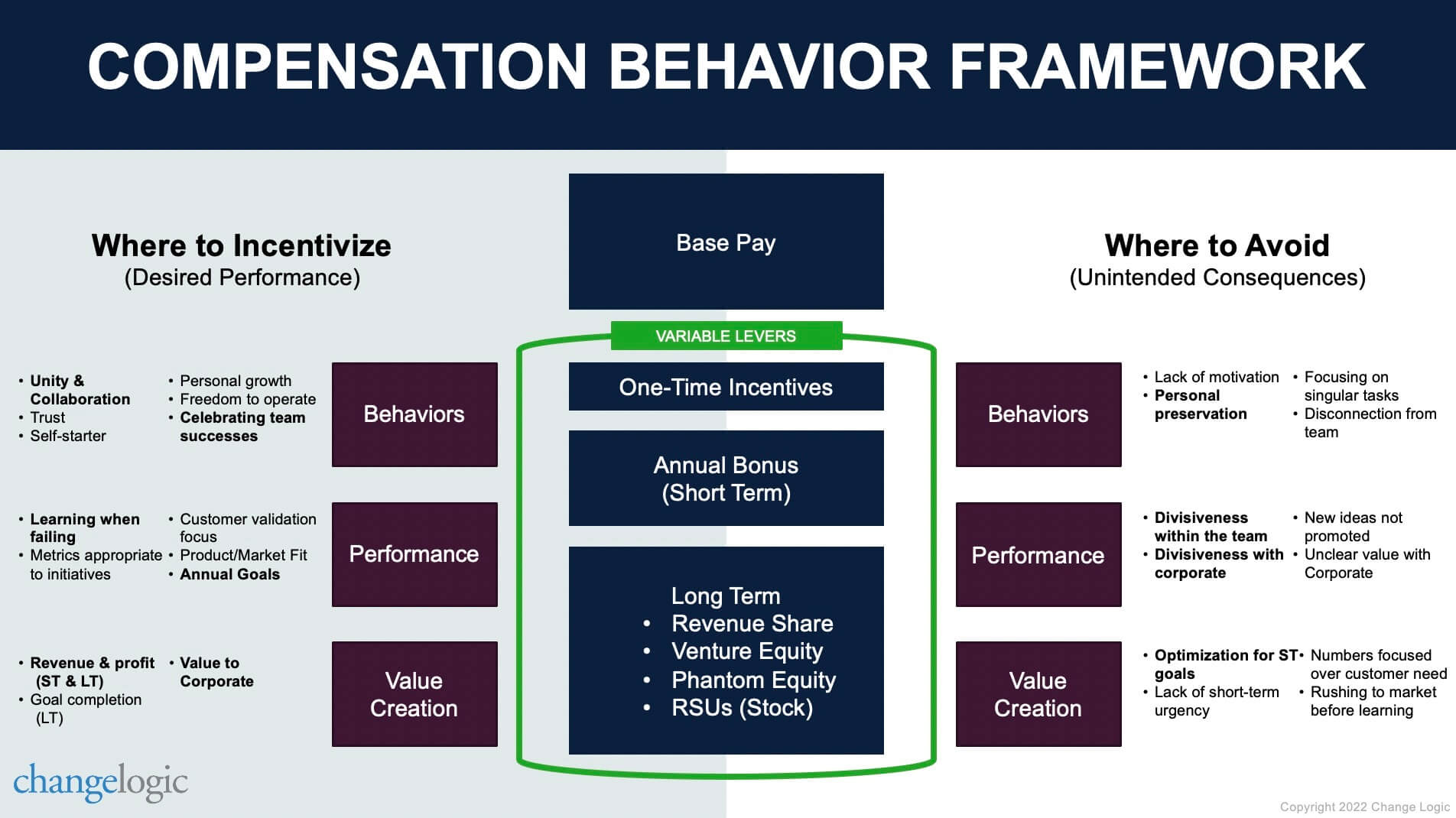In Part 1 & 2 of this series on compensation for innovation teams, we covered the importance of creating a compensation strategy, the pitfalls corporates fall into, and how to start connecting your group’s strategy to desired behaviors with compensation levers. Next, we’ll cover how to pull the pieces together with examples from some key types of innovation groups. Last, don’t forget compensation programs need to be approved by leadership, so we’ll dive into appropriately right-sizing compensation with the opportunity for acceptance.
Aligning to your team’s structure
Many types of innovation or new venture groups exist, but our experience has seen the following most commonly used:
- Innovation Lab
- Accelerator / Incubator
- Venture Studio
- Emerging Business Opportunity Program
Since each of the above organization types usually have different objectives, it is useful to use the team’s structure to start determining which compensation levers should make up your compensation strategy. As covered in Part 2, the strategy should drive the structure which then can easily inform which compensation levers to consider and which to avoid. Be sure to have the correct branding internally AND externally for your group in order to have the best shared understanding of what you want to accomplish. Said differently, far too many innovation labs are “incubators” or a venture studio is branded an “accelerator”.
Innovation Labs
Generally, the scope for these structures moves from closer to the core to transformational or disruptive (depending on which strategy chart you use). Innovation Labs will focus on more near-term core / adjacent opportunities usually with a new product / service offering or an altered existing solution in a new market for the larger corporations. The usual outcome is a product or service that can be brought back into the core company to then be scaled through existing channels or added to product / service suites. Investment levels are incremental and the compensation levers should generally be closer to (but not match) the corporate structure.
| Example: | A core internal innovation team that focuses on mostly on adjacent opportunities via new products/services or new markets the traditional business unit has difficulty executing against |
| Goal & Time Horizon: | Additional revenue from existing customers or new customers with modified existing offerings within 18-36 months |
| Intended Result: | Revenue growth, improved profitability |
| Behaviors Needed: | Collaboration, Creativity |
| Comp Levers to Consider: | Base, Bonus, One-time bonus, RSUs |
| Comp Levers to Avoid: | Revenue Share, Equity, Phantom Equity |
Compensation levers should focus on enhancing the team’s ability to work together, find and test new ideas, and commercialize them. Given the shorter time frame for results, a larger annual bonus and RSU offering would provide the right incentive to motivate the team.
Corporate Accelerators / Incubators
Corporates often create internal accelerators and incubators and while these have different objectives, the compensation structure can be quite similar. Both accelerators and incubators usually share a similar time horizon of 3-5 years with potential for either a new venture or new business unit. It is important to decide early with the ExecCo which is more likely as it is extremely difficult to create new standalone ventures AND new business units within the same group.
| Example: | A hybrid team that operates with an internal core team focused on building new offerings in new markets. Usually new offerings are both developed internally and brought in from external |
| Goal & Time Horizon: | New business unit or spun off stand-alone venture within 3-5 years |
| Intended Result: | Significant revenue capture with scalability to business unit level revenue (10-25% of total company revenue) |
| Behaviors Needed: | Independent & disruptive thinking, comfort with ambiguity, courage to take risks, openness to learning to fail |
| Comp Levers to Consider: | Base, Bonus, Revenue Sharing, RSUs |
| Comp Levers to Avoid: | Equity, Phantom Equity |
More often than not, the commercialized venture will remain a part of the corporation in some capacity. Due to this, compensation levers will focus more on the mid-term success of the venture. Revenue sharing starts to come into play at this level and it is important to focus on revenue share based on manageable growth (i.e., include a profit component for revenue sharing to occur). This will motivate teams to work together at a single goal: create ventures with the largest accretive revenue.
Corporate Venture Studios
A number of Venture Studios are often misbranded as Accelerators. These are units within Corporates typically focused on the very disruptive ideas with more complex business models, hence needing much longer time horizons to scale. Venture Studios will do more with external resources than the first two groups, bringing in outside capital, partners, and startups. There are usually investing components of Venture Studios either operated in-team or in partnership with Corporate VC.
| Example: | A separate unit funded by the parent company to generate new ventures that will focus on disruptive business models |
| Goal & Time Horizon: | Standalone ventures disrupting a specific market or solution that provides exponential growth opportunities within 5-10 years |
| Intended Result: | Usually standalone venture that is scaled or bought; can be spun back into the organization buying out equity holders |
| Behaviors Needed: | Entrepreneurial, non-corporate approach, scrappy, teamwork, problem-oriented |
| Comp Levers to Consider: | Base, Equity, Phantom Equity |
| Comp Levers to Avoid: | Bonus, One-time bonus, Revenue Share, RSUs |
The structure of these teams usually has a management structure with venture leads / GMs acting as the CEO of the venture as it is developed and scaled. Since the long-term focus is needed for these ventures, equity or phantom equity is recommended as a compensation lever to drive focus towards the long-term success of the venture. If equity is not feasible for your team, revenue share can be used, but should integrate a rolling format paid in arrears to keep talent long term.
Emerging Business Opportunity (EBO) Programs
The fourth section is an Emerging Business Opportunity program which are groups set up for ideation, incubation, and scaling of new ideas. Labs, Accelerators, and Venture Studios are usually well suited to execute against one or two of ideation, incubation, and scaling which is why Emerging Business Opportunities are vital to having a successful Ambidextrous Organization. In order for EBOs to be successful, they will continuously have new ideas and ventures being developed with commitment to the group for an extended period of time (some EBOs last 15+ years). This allows the company to have a consistent stream of early, mid, and mature stage ventures to stay competitive in its respective markets (e.g., Hunting Zones).
| Example: | An internal unit focused on capturing market share in strategic hunting zones focused on meaningful growth leveraging internal and external assets from the parent corporate |
| Goal & Time Horizon: | Internal ventures disrupting a specific market or solution that provides exponential growth opportunities within 5-10 years to become the next business unit |
| Intended Result: | The next large strategic business unit for the corporation with the ability to be the new core business |
| Behaviors Needed: | Curiosity, tenacity, non-corporate approach, teamwork, problem-oriented |
| Comp Levers to Consider: | Base, Bonus, One-time bonus, Revenue Share, RSUs |
| Comp Levers to Avoid: | Equity, Phantom Equity |
For EBOs compensation levers can and should vary by role within each opportunity. Longer term components will work well, while short-term metrics run the risk of gamification of bonuses. One-time bonuses will be good for reinforcing the desired behaviors. Given team members may come and go with longer term groups, it is important to focus compensation for more senior members to be long-term oriented while more junior members may be closer to a traditional model with more upside.
The Upside Paradox – Lose the ego to build the right teams
A major challenge for innovation and new venture teams is getting the right talent to build the new growth lever for a corporation. You may think a serial entrepreneur is the ‘silver bullet’, but how can you actually attract that talent? Remember, they are a serial entrepreneur so probably despise corporate structures.
So, will you instead find the most ‘innovative’ employees you have from the corporate office and let them ‘do innovation’ with a similar pay structure? (Hint: that won’t work either)
You will need an attractive and adaptive compensation plan that provides the appropriate upside to achieve the results you want. Easy enough, right? Pay to play!
Well, what happens when you find the right person that builds a $100M venture and they have either revenue sharing or reasonable equity? Will the Exec Co be willing to stomach the fact that a venture leader made more than the CEO in a given year?
That’s where you need to right size opportunities from an agnostic perspective. The current business unit that does $100M of annual revenue– how much capital did it take to get there? Or the acquisition of a $100M revenue company–how much money did you just put in the founder’s pocket when your company bought them for $500M? It is important to remember that outsized results deserve outsized compensation so that your Corporate Explorers will remain motivated which then will attract your next cohort of Corporate Explorers.
If it was easy, everyone would do it… so don’t let compensation block you
As we’ve discussed across all 3 parts of this series, corporate innovation and new ventures is extremely difficult and takes a lot of pieces going in the right direction to truly create meaningful incremental growth. The success of these groups is tied directly to the team members and how they operate and behave – so why overlook their compensation that may be their motivator when times are challenging?

